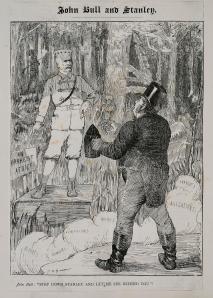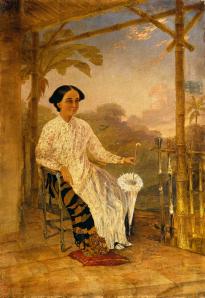
A Malay native from Batavia at Coepang, portrait of Mohammed Jen Jamain by Thomas Baines. Courtesy of the Royal Geographical Society
The history of exploration does not have its own departments in universities. It does not really exist as a historical sub-discipline either, at least in the way that formalized fields such as labor history, women’s history and political history do. Instead, the history of exploration is a disciplinary interloper, a subject taken up by many fields such as literary studies, anthropology, geography, and the history of science. Each brings its own unique perspective and methods. Each has its own preoccupations and biases.
All of which makes the work of Felix Driver, professor of human geography at Royal Holloway, University of London, especially important. While Driver has covered many of the meat-and-potatoes subjects in exploration: navigation, shipwrecks, and biographical subjects such as Henry Morton Stanley and David Livingstone, he has framed them in the broadest context: through the visual arts, postmodern theory, social history, and historical geography.
He is the author of many books and articles including Geography Militant: Cultures of Exploration and Empire. He is also the co-editor of Tropical Visions in an Age of Empire which came out with University of Chicago Press in 2005.
At the same time, Driver has worked to bring these subjects to the attention of the public, supervising the new Royal Geographical Society exhibition, Hidden Histories of Exploration. The exhibition, which opened on October 15, “offers a new perspective on the Society’s Collections, highlighting the role of local inhabitants and intermediaries in the history of exploration.”
Driver took some time to speak with me about the exhibition and his work on exploration.
Welcome Felix Driver.
What inspired the Hidden Histories exhibition?
A conviction that the history of exploration was about a wider, collective experience of work and imagination rather than simply a story of lone individuals fighting against the odds. The idea of ‘hidden histories’ has an innate appeal – it suggests stories that have not been heard, which have been hidden from history, waiting to be uncovered. It has already provided the RGS with a model for a series of exhibitions linking aspects of their Collections with communities in London. The Society’s strong commitment to public engagement in recent years provided an opportunity for a more research-oriented exhibition which asked a simple question: can we think about exploration differently, using these same Collections which have inspired such great stories about heroic individuals? This was a kind of experiment, in which the Collections themselves were our field site: together with Lowri Jones, a researcher on the project, we set out to explore its contours, trying to make these other histories more visible.

Hidden Histories uses RGS collections to look at “role of local peoples and intermediaries in the history of global exploration.” Those of us who study exploration get excited by this, but how do you pitch it to the general public? How do you engage the exploration buff interested only in Peary, Stanley, or Columbus?
That’s a good question. The exploration publishing industry has returned over and over to the same stories. The lives of great explorers continue to sell well, and that is one aspect of the continuing vitality of what I call our culture of exploration. Still, recent developments in the field and in popular science publishing have encouraged authors and readers to shift the focus somewhat, turning the spotlight on lesser known individuals whose experiences have been overshadowed. Consider for example the success of some terrific popular works on the theme of exploration and travel such as Robert Whitaker’s The Mapmaker’s Wife, or Matthew Kneale’s novel English Passengers, which are all about large and complex issues of language, translation, misunderstanding and exchange. That gives you a bit of hope that actually readers are looking for something new, so long as there is a good story there! Of course it is not easy – so much simpler to tread the path of our predecessors. Sometimes it requires an exploring spirit to venture further from the beaten track….

What first drew you to the history of exploration? Is there particular question or theme that guides your research? How have your interests changed over time?
What drew me first to the history of exploration was a growing realization that the subject was more important to my own academic field – geography – than my teachers in the 1970s were prepared to admit. I was interested in the worldly role and impact of geographical knowledge, socially, economically and politically. When I was at school and college, ‘relevance’ was in the air and geographers were turning their attention to questions of policy and politics. My point was that geographical knowledge has been and continued to be hugely significant in the world beyond the academic, from travel writing to military mapping, and exploration provided one way into this. There were other ways into this worldly presence, of course, and the work of my PhD supervisor Derek Gregory has had a lasting influence.
Much of my own writing has focused strongly on the long nineteenth century, partly because this was a period in which I immersed myself for my PhD and first teaching (my first post was a joint appointment in history and geography). However, I was drawn to the work of social historians – at first EP Thompson’s Making of the English Working Class, later work influenced by new models of cultural history. Partly because of my appointment on the borders of two disciplines, I found myself increasingly attracted to fields – such as Victorian studies or the history of science – that were in a sense already interdisciplinary. In both these cases, an interest in space and location has had a strong impact on the best writing in the field. Historians like Jim Secord and Dorinda Outram, as well as geographers such as David N. Livingstone and Charles Withers, taught me a lot about the ways in which ideas about exploration circulate, and why it is important to think of knowledge in practical as well as intellectual terms.
My interest in the visual culture of exploration and travel reflects the strong focus on the visual has shaped the work of geographers in this area, pre-eminently Stephen Daniels and Denis Cosgrove. My interests developed through work with James Ryan, whose book on the photographic collections of the RGS remains a seminal work. Later I worked with Luciana Martins on a project on British images of the tropical world in which we were particularly concerned with the observational skills of ordinary seamen and humble collectors rather than the grand theorists of nature. In retrospect, this project paved the way for some of the themes in the hidden histories of exploration exhibition. But this exhibition also represents a departure for me as the focus is squarely on the work of non-Europeans. There is an interesting discussion to be had here about whether turning figures like Nain Singh or Jacob Wainwright into ‘heroes’, just like Stanley or Livingstone, is the way to go. Perhaps we can’t think of exploration without heroes, and it’s a matter of re-thinking what we mean by heroism. Or perhaps we historians need to do more than ruminate on the vices and virtues of particular explorers, by considering the networks and institutions which made their voyages possible and gave them a wider significance.
In Geography Militant, you warned that scholars were focusing on exploration too much as an “imperial will-to-power” [8] ignoring the unique and contingent qualities of each expeditionary encounter. You developed this argument further in Tropical Visions in an Age of Empire. Do you think scholars are now moving away from an “empire-is-everywhere” world view? If so, what do you think we are moving towards?
This is not an original view. Many of the best known historians and literary critics writing on empire have made similar points: I am thinking of Peter Hulme, Catherine Hall and Nicholas Thomas. What I take from them is a deep sense of what colonialism and empire meant – not just at the level of trumpets and gunboats, but in the very making of our sense of ourselves and our place in the world, past and present. At the same time, I have wanted to highlight the fractured, diverse nature of the colonial experience and I have never been happy with lumpen versions of ‘colonial discourse’ which used to be advanced within some versions of postcolonial theory. This interest in difference is reflected in my interest in moments of controversy and crisis, points where the uncertainties and tensions come to the surface (as in controversies over the expeditions of Henry Morton Stanley). You can’t work on exploration for long without realizing the strong emotional pull of the subject on explorers and their publics; and the fact quite simply that they were always arguing, either with ‘armchair geographers’ (those much maligned stay-at-homes) or with their peers. If these arguments were frequently staged if not orchestrated by others, that is part of the point: these controversies were more than simply the product of disputatious personalities, they were built in to the fabric of the culture which produced them.
What’s your next project?
In recent years I have worked on a variety of smaller projects on collectors and collecting, involving everything from insects to textiles. What I would like to do next is a book on the visual culture of exploration, drawing on a wide variety of materials from sketch-books to film. Some of these materials are represented in the hidden histories exhibition, notably the sketchbooks of John Linton Palmer and the 1922 Everest film featured on the website. But there is much left to explore!
Thanks for speaking with me.
Your work focuses on many issues besides the history of exploration, including visual arts, the geography of cities, and questions of identity and empire.












Leave a comment